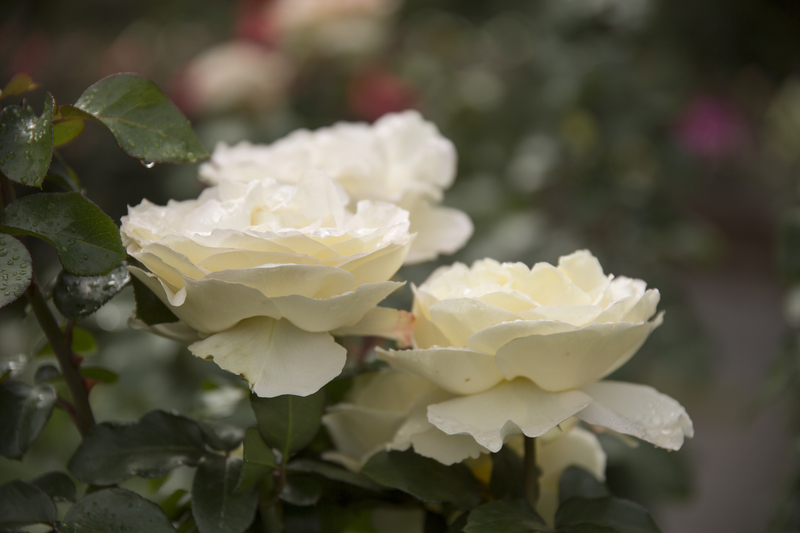Elevate Your Green Thumb with Vertical Gardening
Posted on 18/06/2025
Elevate Your Green Thumb with Vertical Gardening: A Comprehensive Guide
If you're looking to make the most of your gardening space or simply want to try a creative way to grow plants, vertical gardening offers an ingenious solution. Not only does it transform limited space into lush, productive gardens, but it also brings numerous environmental and aesthetic benefits. Whether you're a seasoned gardener or just starting out, this guide will introduce you to the world of upward gardening, helping your "green thumb" reach new heights.

What is Vertical Gardening?
Vertical gardening is a method of growing plants on upright surfaces, rather than in the traditional horizontal ground beds. This innovative gardening technique uses walls, trellises, shelves, or specially designed structures to support plant growth, making it ideal for urban environments, small backyards, balconies, and even indoor spaces.
Benefits of Vertical Gardening
- Maximizes Space: Grow more in less area by utilizing unused vertical spaces.
- Improves Air Quality: Plants cleanse the air, making your home fresher and healthier.
- Enhances Aesthetic Appeal: Lush green walls and cascading vines beautify any environment.
- Reduces Pests and Diseases: Better air circulation decreases fungal problems and pests.
- Eases Maintenance: No need for constant bending; vertical gardens can be more accessible.
- Boosts Mental Well-being: Greenery and gardening are scientifically proven to relieve stress.
How to Start Your Vertical Garden
Anyone can begin their journey with vertical gardening, regardless of space or experience. Here's a step-by-step guide to setting up your own vertical oasis.
1. Choose the Right Location
Location is crucial for successful gardening. Consider the following:
- Lighting: Most vegetables, herbs, and flowering plants need at least six hours of sunlight. Assess if the spot is sunny or shaded.
- Accessibility: Make sure your garden is easy to reach for watering, maintenance, and harvest.
- Structural Support: Walls, fences, or balconies should be sturdy enough to support the weight of your vertical garden.
2. Select Your Vertical Gardening System
There are many types of vertical planters to choose from, each with unique advantages:
- Trellises: Perfect for climbing plants like peas, cucumbers, jasmine, and roses.
- Pocket Planters: Made from felt or fabric, these allow for a living wall of herbs or leafy greens.
- Pallet Gardens: Upcycled pallets make creative, affordable planters for flowers, succulents, and vegetables.
- Modular Systems: Stackable and customizable kits designed for modern living spaces.
- Hanging Planters: Good for trailing plants such as strawberries and pothos.
- DIY Options: Get creative with shoe organizers, upcycled bottles, or gutter gardens!
3. Choose Suitable Plants for Vertical Growth
The best plants for vertical gardens are those that grow upwards or trail down naturally. Top picks include:
- Vining Vegetables: Tomatoes, peas, pole beans, cucumbers, squash, and melons.
- Herbs: Basil, chives, oregano, mint, parsley, thyme, and rosemary.
- Leafy Greens: Lettuce, spinach, arugula, Swiss chard, kale.
- Flowers: Nasturtiums, petunias, morning glories, and fuchsias.
- Succulents: Sedum, echeveria, hens-and-chicks for low maintenance options.
Tip: Consider the plant's mature size, light needs, and growth habit to ensure harmony in your garden wall.
4. Prepare Soil & Irrigation
Vertical gardens dry out more quickly than traditional beds, so a high-quality, moisture-retentive potting mix is essential. Add compost or slow-release fertilizer for nutrients. For convenience, consider a drip irrigation system or soaker hoses--especially for larger living walls.
Creative Vertical Gardening Ideas
Looking for inspiration to start your own vertical oasis? Here are some innovative and functional ideas to elevate your gardening skills:
Pallet Wall Garden
Repurpose an old wooden pallet by adding landscape fabric and filling with potting soil to create a rustic, pocketed garden. Perfect for herbs and salad greens.
Shoe Organizer Planter
Hang an unused fabric shoe organizer on a sunny wall, fill each pocket with soil, and plant herbs for a quirky, space-saving garden.
Rain Gutter Garden
Mount horizontal gutter sections along a fence or wall, drilling drainage holes and planting strawberries, lettuce, or flowers.
Living Green Wall
For a dramatic effect, install a modular green wall system indoors or out. These can feature automatic watering and lighting, creating a spectacular and functional art piece.
Bottle Tower Planters
Stack recycled plastic bottles to construct vertical towers for smaller plants, reducing waste while maximizing yield.
Tips for Maintaining a Thriving Vertical Garden
- Regular Watering: Vertical gardens often require more frequent watering as soil dries faster. Monitor the moisture level, especially on hot days.
- Feeding: Use liquid fertilizers or slow-release granules to replenish nutrients washed out by frequent watering.
- Prune and Train: Regularly trim and guide plants to encourage healthy growth and proper coverage.
- Pest Management: Look out for pests; keep your garden healthy with organic sprays or natural predators like ladybugs.
- Replenish Soil: Annually renew soil amendments and compost to maintain fertility and pH balance.
Vertical Gardening Indoors: Bring the Outdoors In
Vertical gardens are not limited to outdoor spaces! They make a beautiful statement indoors as well. Living walls in the kitchen, living room, or even bathroom can improve air quality and morale while creating a focal point in your design.
Best Indoor Vertical Garden Plants
- Spider Plant: Hardy and air-purifying.
- Pothos: Trailing beauty for low-light spots.
- Herbs: Place near a kitchen window for fresh, handy ingredients.
- Ferns: Require moderate humidity, looking lush in bathrooms.
- Peace Lily: Great for brightening corners and purifying air.
Indoor Vertical Gardening Systems
- Wall Planters: Ceramic or plastic modules that attach to walls.
- Freestanding Frames: Moveable structures perfect for rented spaces.
- Hydroponic Towers: Soil-free options for a futuristic, mess-free indoor jungle.
Eco-Friendly Benefits of Vertical Gardening
Vertical gardening goes beyond maximizing space; it's an eco-friendly choice that aids sustainability.
- Urban Cooling: Vertical gardens shield walls from direct heat, lowering indoor temperatures.
- Rainwater Utilization: Capture and channel rainwater for irrigation.
- Increased Biodiversity: Supports pollinators and local wildlife, especially in city environments.
- Insulating Properties: Living walls help reduce energy bills by adding an extra layer of insulation.
Common Challenges and Solutions in Vertical Gardening
Even the best green thumbs may encounter obstacles, but most vertical gardening issues have quick fixes:
- Drying Out: Use water-retentive soil, add mulch, or install a drip irrigation system.
- Overcrowding: Stick to recommended plant spacing and regularly trim back vigorous growers.
- Poor Growth: Ensure sufficient sunlight and supplement with grow lights indoors.
- Structural Instability: Check supports regularly and reinforce as necessary.
- Pest Infestation: Practice crop rotation, encourage beneficial insects, and capture pests early.

Frequently Asked Questions About Vertical Gardening
Can I grow vegetables in a vertical garden?
Absolutely! Many vegetables, especially vining and leafy types, are perfect for vertical gardening. Just ensure appropriate container depth and support.
What is the best soil for vertical gardening?
A high-quality potting mix with good drainage and moisture retention is ideal. Combine with compost or worm castings for extra nutrients.
Do vertical gardens need more maintenance than traditional gardens?
Vertical gardens can require more attention to watering and occasional support or pruning but often have fewer weeds and easier harvesting.
Conclusion: Grow Upward--Elevate Your Gardening Game
Vertical gardening is more than a trend; it's a smart solution for those wanting to garden in small spaces, reduce their environmental impact, and create a stunning visual display. With a bit of planning and creativity, anyone can transform a bare wall, balcony, or patio into a thriving vertical oasis.
From apartment dwellers to homeowners with sprawling backyards, anyone can elevate their green thumb with the art and science of vertical gardening. So, gather your supplies, choose your favorite plants, and let your garden reach new heights--literally!
- Ready to start your vertical journey? Share your ideas and photos with our gardening community and inspire others to grow upward!





